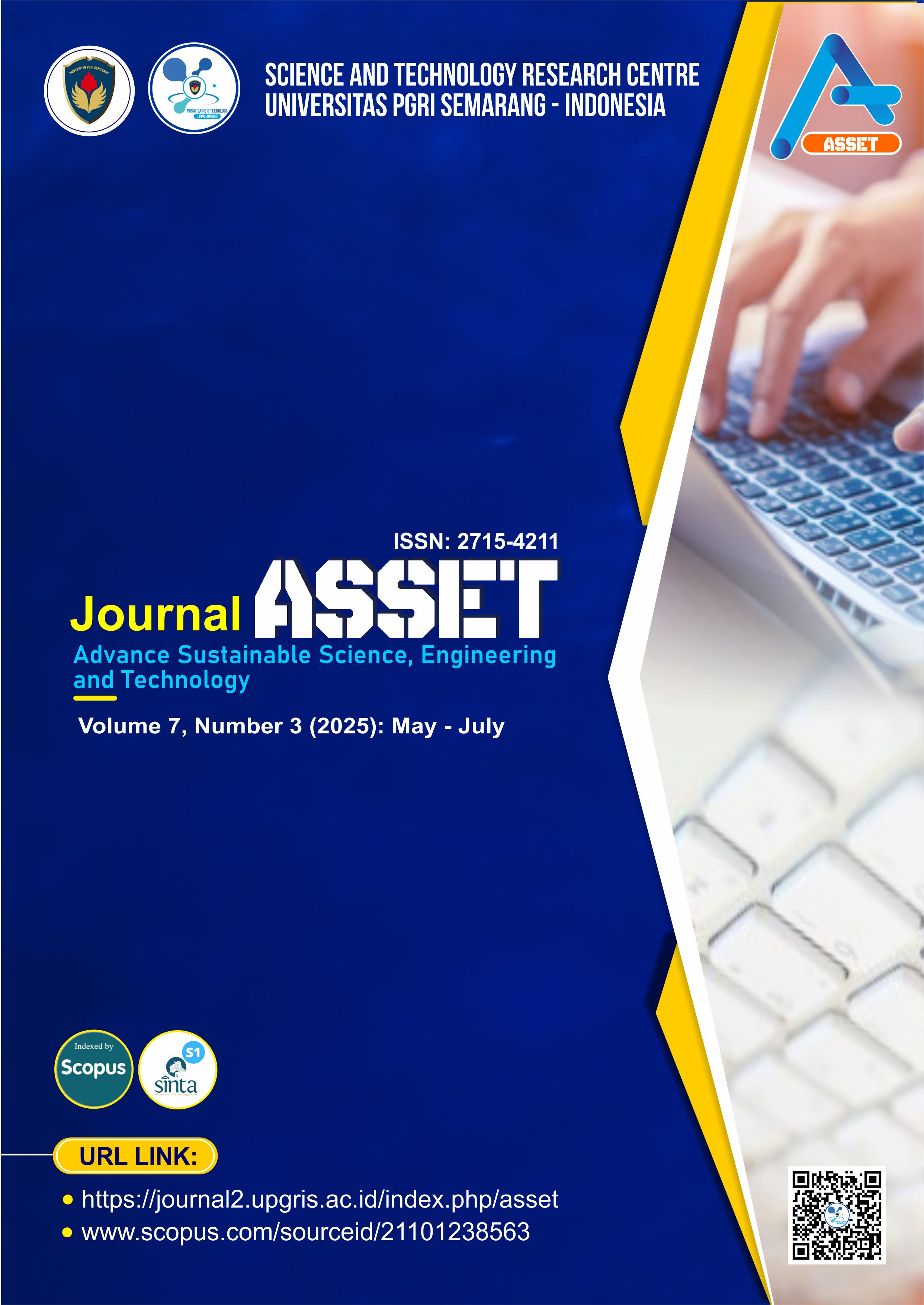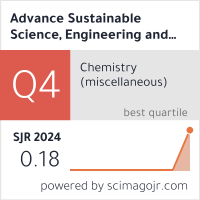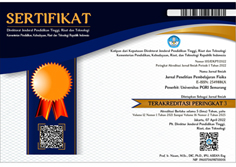Exploring Biochar Briquettes from Biomass Waste for Sustainable Energy
DOI:
https://doi.org/10.26877/asset.v7i3.1311Keywords:
Biochar briquettes, biomass conversion, carbon sequestration, calorific value, moisture content, renewable energyAbstract
The increasing demand for renewable energy necessitates sustainable alternatives such as biochar briquettes derived from agricultural waste. This study aims to optimize the production process and evaluate the physical, mechanical, and combustion properties of biochar briquettes made from corn residues, rice husks, and coconut shells. The methodology includes biomass carbonization, binder ratio optimization, and systematic testing of key quality parameters such as moisture content, density, ash content, and calorific value. Results indicate that an optimal biomass-to-binder ratio yields a high calorific value (7,192 kcal/kg) and low ash content (3.57%), enhancing combustion efficiency. Maintaining moisture content below 10% enhances ignition and prolongs burning time. These findings highlight biochar briquettes' role in carbon sequestration, biomass conversion, and sustainable waste management, supporting the circular economy and reducing environmental pollution. Biochar briquettes offer a clean, accessible energy solution, contributing to global energy security and climate change mitigation.
References
[1] M. Roy and K. Kundu, “Production of biochar briquettes from torrefaction of pine needles and its quality analysis,” Bioresour. Technol. Reports, vol. 22, p. 101467, 2023.
[2] P. S. A. Sitogasa, M. Mirwan, and F. Rosariawari, “Potential of Biomass Briquettes from Tropical Fruit Waste (Study Case: Durian Skin),” 2023.
[3] W. Fitriana and D. W. Febrina, “Analisis Potensi Briket Bio-Arang Sebagai Sumber Energi Terbarukan Analysis of Potency of Biocharcoal Briquettes As a Renewable Energy Source,” J. Tek. Pertan. Lampung, vol. 10, no. 2, pp. 147–154, 2021.
[4] S. E. Ibitoye et al., “An overview of biochar production techniques and application in iron and steel industries,” Bioresour. Bioprocess., vol. 11, no. 1, p. 65, 2024.
[5] S. Al Hosni, M. Domini, R. Vahidzadeh, and G. Bertanza, “Potential and Environmental Benefits of Biochar Utilization for Coal/Coke Substitution in the Steel Industry,” Energies, vol. 17, no. 11, p. 2759, 2024.
[6] M. Zulhusni, C. A. Sari, and E. H. Rachmawanto, “Implementation of DenseNet121 Architecture for Waste Type Classification,” Adv. Sustain. Sci. Eng. Technol., vol. 6, no. 3, p. 2403015, 2024.
[7] T. N. Arier, R. Rochmoeljati, and I. Nugraha, “Waste Analysis in The Production Process Urea Fertilizer Using The Lean Six Sigma Method and Recommendations for Improving Failure Mode Effect Analysis (FMEA) at PT. Damai Sejahtera,” Adv. Sustain. Sci. Eng. Technol., vol. 6, no. 3, p. 240303, 2024.
[8] R. Siskandar, B. R. Kusumah, and L. C. Astuti, “Performance Analysis of Disc Mill Type FFC-15 Grinder for Making Charcoal Husk Flour,” J. Tek. Pertan. Lampung (Journal Agric. Eng., vol. 13, no. 4, pp. 1121–1131, 2024.
[9] M. K. Zafeer, R. A. Menezes, H. Venkatachalam, and K. S. Bhat, “Sugarcane bagasse-based biochar and its potential applications: a review. Emergent Materials, 7 (1), 133–161.” DOI, 2024.
[10] M. Melenia, S. Ahzan, and D. Pangga, “Effect of Base Material Variations on the Characteristics of Briquettes from Coconut Shell Charcoal and Corncob Mixtures,” Lensa J. Kependidikan Fis., vol. 12, no. 2, pp. 178–196, 2024.
[11] M. Sparrevik, H. Lindhjem, V. Andria, A. M. Fet, and G. Cornelissen, “Environmental and socioeconomic impacts of utilizing waste for biochar in rural areas in Indonesia–a systems perspective,” Environ. Sci. Technol., vol. 48, no. 9, pp. 4664–4671, 2014.
[12] M. S. Ibrahim, S. Bello, and A. Ibrahim, “Biomass briquettes as an alternative source of cooking fuel towards green recovery post COVID-19,” Saudi J. Eng. Technol., vol. 5, no. 6, pp. 285–290, 2020.
[13] S. Winarsih and D. D. Siskawardani, “Hydrolysis of corncobs using a mixture of crude enzymes from Trichoderma reesei and Aspergillus niger for bioethanol production,” Energy Reports, vol. 6, pp. 256–262, 2020.
[14] D. N. Shekhar, “Popularization of biomass briquettes: a means for sustainable rural development,” Asian J. Manag. Res., vol. 2, no. 1, pp. 457–473, 2011.
[15] G. I. Ngene, B. Bouesso, M. González, and A. Nzihou, “A review on biochar briquetting: Common practices and recommendations to enhance mechanical properties and environmental performances,” J. Clean. Prod., p. 143193, 2024.
[16] Z. Ginting et al., “Pyrolyzed Bio Charcoal Briquettes Of Solid Waste From Lhokseumawe Patchouli Oil Refinery,” in Proceedings of Malikussaleh International Conference on Multidisciplinary Studies (MICoMS), 2022, vol. 3, p. 2.
[17] J. Waluyo, M. M. Setianto, N. R. Safitri, S. H. Pranolo, and A. D. Susanti, “Characterization of biochar briquettes from coconut shell with the effect of binder: molasses, cow manure and horse manure,” 2023.
[18] M. Mujtaba et al., “Lignocellulosic biomass from agricultural waste to the circular economy: a review with focus on biofuels, biocomposites and bioplastics,” J. Clean. Prod., vol. 402, p. 136815, 2023.
[19] O. K. Fadele, T. O. Amusan, A. O. Afolabi, and C. A. Ogunlade, “Characterisation of briquettes from forest wastes: Optimisation approach,” Res. Agric. Eng., vol. 67, no. 3, pp. 138–147, 2021, doi: 10.17221/6/2021-RAE.
[20] S. Yu, V. Lew, W. Ma, Z. Bao, and J. L. Hao, “Unlocking key factors affecting utilization of biomass briquettes in Africa through SWOT and analytic hierarchy process: A case of Madagascar,” Fuel, vol. 323, p. 124298, 2022, doi: https://doi.org/10.1016/j.fuel.2022.124298.
[21] S. Y. Kpalo, M. F. Zainuddin, L. A. Manaf, and A. M. Roslan, “A Review of Technical and Economic Aspects of Biomass Briquetting,” Sustainability, vol. 12, no. 11. 2020, doi: 10.3390/su12114609.
[22] J. Tanko, U. Ahmadu, U. Sadiq, and A. Muazu, “Characterization of rice husk and coconut shell briquette as an alternative solid fuel,” Adv. Energy Convers. Mater., pp. 1–12, 2021.
[23] Z. Wang et al., “Research on the improvement of carbon neutrality by utilizing agricultural waste: Based on a life cycle assessment of biomass briquette fuel heating system,” J. Clean. Prod., vol. 434, p. 140365, Dec. 2023, doi: 10.1016/j.jclepro.2023.140365.
[24] A. Alengebawy et al., “A comparative environmental life cycle assessment of rice straw-based bioenergy projects in China,” Environ. Res., vol. 212, p. 113404, 2022, doi: https://doi.org/10.1016/j.envres.2022.113404.
[25] R. N. Ossei-Bremang, E. A. Adjei, and F. Kemausuor, “Multivariate decisions: Modelling waste-based charcoal briquette formulation process,” Bioresour. Technol. Reports, vol. 22, p. 101483, 2023, doi: https://doi.org/10.1016/j.biteb.2023.101483.
[26] S. V Vassilev, C. G. Vassileva, Y.-C. Song, W.-Y. Li, and J. Feng, “Ash contents and ash-forming elements of biomass and their significance for solid biofuel combustion,” Fuel, vol. 208, pp. 377–409, 2017.
[27] S. A. Adesanya, J. S. Ibrahim, A. Kuhe, and A. A. Ndah, “Assessment of mechanical, physical, and thermal characterization of jujube seed shell briquettes,” Bioresour. Technol. Reports, vol. 26, p. 101868, 2024, doi: https://doi.org/10.1016/j.biteb.2024.101868.
[28] A. Mustafa et al., “Food and agricultural wastes-derived biochars in combination with mineral fertilizer as sustainable soil amendments to enhance soil microbiological activity, nutrient cycling and crop production,” Front. Plant Sci., vol. 13, p. 1028101, 2022.
[29] S. Ghosh, M. Nandasana, T. J. Webster, and S. Thongmee, “Agrowaste-generated biochar for the sustainable remediation of refractory pollutants,” Front. Chem., vol. 11, p. 1266556, 2023.
[30] P. R. Yaashikaa, P. S. Kumar, S. Varjani, and A. Saravanan, “A critical review on the biochar production techniques, characterization, stability and applications for circular bioeconomy,” Biotechnol. reports, vol. 28, p. e00570, 2020.
[31] K. Wystalska and A. Kwarciak-Kozłowska, “The effect of biodegradable waste pyrolysis temperatures on selected biochar properties,” Materials (Basel)., vol. 14, no. 7, p. 1644, 2021.
[32] E.-S. Khater, A. Bahnasawy, R. Hamouda, A. Sabahy, W. Abbas, and O. M. Morsy, “Biochar production under different pyrolysis temperatures with different types of agricultural wastes,” Sci. Rep., vol. 14, no. 1, p. 2625, 2024.
[33] C. Hadey, M. Allouch, M. Alami, F. Boukhlifi, and I. Loulidi, “Preparation and characterization of biochars obtained from biomasses for combustible briquette applications,” Sci. World J., vol. 2022, no. 1, p. 2554475, 2022.
[34] D. Pierson et al., “Beyond the basics: a perspective on barriers and opportunities for scaling up biochar production from forest slash,” Biochar, vol. 6, no. 1, p. 1, 2024.
[35] M. N. Rashif, S. Hartini, D. P. Sari, B. S. Ramadan, T. Matsumoto, and A. T. Balasbaneh, “Life cycle assessment of biomass waste briquettes as renewable energy,” Glob. J. Environ. Sci. Manag., vol. 11, no. 1, pp. 207–224, 2025.
[36] Z. Said et al., “Intelligent approaches for sustainable management and valorisation of food waste,” Bioresour. Technol., vol. 377, p. 128952, 2023.
[37] R. N. Ossei-Bremang, E. A. Adjei, F. Kemausuor, T. Mockenhaupt, and T. Bar-Nosber, “Effects of compression pressure, biomass ratio and binder proportion on the calorific value and mechanical integrity of waste-based briquettes,” Bioresour. Technol. Reports, vol. 25, p. 101724, 2024.
[38] P. Jittabut, “Physical and thermal properties of briquette fuels from rice straw and sugarcane leaves by mixing molasses,” Energy Procedia, vol. 79, pp. 2–9, 2015.
[39] O. Urbanovičová, K. Krištof, P. Findura, J. Jobbágy, and M. Angelovič, “Physical and mechanical properties of briquettes produced from energy plants,” Acta Univ. Agric. Silvic. Mendelianae Brun., vol. 65, no. 1, pp. 219–224, 2017.
[40] R. M. Davies and O. A. Davies, “Physical and combustion characteristics of briquettes made from water hyacinth and phytoplankton scum as binder,” J. Combust., vol. 2013, no. 1, p. 549894, 2013.
[41] T. Kebede, D. T. Berhe, and Y. Zergaw, “Combustion characteristics of briquette fuel produced from biomass residues and binding materials,” J. Energy, vol. 2022, no. 1, p. 4222205, 2022.
[42] R. Eka Putri and A. Andasuryani, “Studi mutu briket arang dengan bahan baku limbah biomassa,” J. Teknol. Pertan. Andalas, vol. 21, no. 2, p. 143, 2017.
[43] Machalmina, A. S. Ismy, and M. Razi, “Pengaruh variasi tekanan terhadap karakteristik biobriket cangkang kelapa sawit dengan menggunakan mesin pencetak biobriket,” J. Mesin Sains Terap., vol. 6, no. 2, pp. 110–116, 2022.
[44] T. Kan, V. Strezov, and T. J. Evans, “Lignocellulosic biomass pyrolysis: A review of product properties and effects of pyrolysis parameters,” Renew. Sustain. energy Rev., vol. 57, pp. 1126–1140, 2016.
[45] S. V Vassilev, D. Baxter, L. K. Andersen, and C. G. Vassileva, “An overview of the chemical composition of biomass,” Fuel, vol. 89, no. 5, pp. 913–933, 2010.
[46] M. Y. P. Setyono and Y. S. Purnomo, “Analisis Kadar Air dan Kadar Abu Briket Lumpur IPAL dan Fly Ash dengan Penambahan Serbuk Gergaji Kayu,” INSOLOGI J. Sains dan Teknol., vol. 1, no. 6, pp. 696–703, 2022.
[47] B. S. A. Siregar, A. Ruswanto, and E. Adisetya, “Pemanfaatan Tandan Kosong Kelapa Sawit dan Cangkang Biji Karet sebagai Bahan Baku Briket Arang dengan Perekat Bentonit,” AGROFORETECH, vol. 1, no. 3, pp. 1951–1960, 2023.
[48] E. E. Crisdiantoro, “Pengaruh Jenis Variasi Perekat pada Briket dari Limbah Ampas Kopi.” Institut Peratanian Stiper Yogyakarta, 2023.
[49] J. V. A. Shafiyya, H. S. Kusumasari, I. M. Praharsiwi, and M. Mujiburohman, “Pengaruh kondisi operasi dan jenis perekat terhadap karakteristik briket ampas teh,” J. Energi Baru dan Terbarukan, vol. 3, no. 3, pp. 249–258, 2022.
[50] A. Kahariayadi, D. Setyawati, F. Diba, and E. Roslinda, “Kualitas arang briket berdasarkan persentase arang batang kelapa sawit (elaeis guineensis jacq) dan arang kayu laban (vitex pubescens vahl),” J. hutan lestari, vol. 3, no. 4, 2015.
[51] D. S. Senchi and C. M. Elinge, “Physiochemical and combustion properties of briquettes produced from rice husk and corncob admixture,” Iconic Res. Eng. J., vol. 3, no. 12, pp. 231–236, 2020.
[52] Y. N. Irbah, T. H. Nufus, and N. Hidayati, “Analisis nilai kalori dan laju pembakaran briket campuran cangkang nyamplung dan tempurung kelapa,” in Prosiding Seminar Nasional Teknik Mesin, 2022, no. 1, pp. 689–694.
[53] Y. Amani and M. Z. Aris, “Variasi Temperatur Torefaksi Pengaruh Terhadap Karakteristik dan Nilai Kalor dari Produk Briket Arang Eceng Gondok,” J. Energi Elektr., vol. 12, no. 1, pp. 14–18, 2023.
[54] A. S. Redjeki, D. Markhaban, A. B. Syamsuddin, and S. A. Yudistirani, “Pengaruh Komposisi Dan Ukuran Partikel Pada Nilai Kalor Biobriket Dari Tandan Pisang Dan Serbuk Gergaji Dengan Penambahan Perekat Tepung Tapioka Dan Tepung Sagu,” Pros. Semnastek, 2022.
[55] J. Titarsole and R. S. Maail, “Analisa kualitas briket arang (studi kasus tanaman bambu di hutan pendidikan desa Honitetu Kabupaten Seram bagian barat),” J. Hutan Pulau-Pulau Kecil, vol. 5, no. 1, pp. 40–55, 2021.
[56] Z. Guo et al., “Characteristics of biomass charcoal briquettes and pollutant emission reduction for sulfur and nitrogen during combustion,” Fuel, vol. 272, p. 117632, 2020.
[57] G. Zhang, Y. Sun, and Y. Xu, “Review of briquette binders and briquetting mechanism,” Renew. Sustain. Energy Rev., vol. 82, pp. 477–487, 2018.
[58] I. E. Onukak, I. A. Mohammed-Dabo, A. O. Ameh, S. I. R. Okoduwa, and O. O. Fasanya, “Production and characterization of biomass briquettes from tannery solid waste,” Recycling, vol. 2, no. 4, p. 17, 2017.
[59] D. Sha, Y. Li, X. Zhou, J. Zhang, H. Zhang, and J. Yu, “Influence of volatile content on the explosion characteristics of coal dust,” ACS omega, vol. 6, no. 41, pp. 27150–27157, 2021.
[60] P. Kipngetich, R. Kiplimo, J. K. Tanui, and P. Chisale, “Effects of carbonization on the combustion of rice husks briquettes in a fixed bed,” Clean. Eng. Technol., vol. 13, p. 100608, 2023.
[61] R. P. Dewi, S. Sumardi, and R. Isnanto, “Analysis of Fixed Carbon and Volatile Matter Briquettes of Pine Sawdust and Coconut Shell Waste,” J. Rekayasa Mesin, vol. 14, no. 3, pp. 901–907, 2023.
[62] A. Tesfaye, F. Workie, and V. S. Kumar, “Production and characterization of coffee husk fuel briquettes as an alternative energy source,” Adv. Mater. Sci. Eng., vol. 2022, no. 1, p. 9139766, 2022.
[63] M. Njenga et al., “Charcoal production and strategies to enhance its sustainability in Kenya,” Dev. Pract., vol. 23, no. 3, pp. 359–371, 2013.
[64] O. A. Oyelaran, B. Olorunfemi, O. M. Sanusi, A. O. Fagbemigun, and O. Balogun, “Investigating the performance and combustion characteristics of composite bio-coal briquette,” J. Mater. Eng. Struct. «JMES», vol. 5, no. 2, pp. 173–184, 2018.
[65] A. Niño, N. Arzola, and O. Araque, “Experimental study on the mechanical properties of biomass briquettes from a mixture of rice husk and pine sawdust,” Energies, vol. 13, no. 5, 2020, doi: 10.3390/en13051060.
[66] T. Wang et al., “Assessment of combustion and emission behavior of corn straw biochar briquette fuels under different temperatures,” J. Environ. Manage., vol. 250, p. 109399, 2019, doi: https://doi.org/10.1016/j.jenvman.2019.109399.
[67] P. Donald, C. Sanchez, M. Me, T. Aspe, and K. N. Sindol, “An Overview on the Production of Bio-briquettes from Agricultural Wastes: Methods, Processes, and Quality,” J. Agric. Food Eng., vol. 3, no. 1, pp. 1–17, 2022, doi: 10.37865/jafe.2022.0036.
[68] S. Yana, M. Nizar, Irhamni, and D. Mulyati, “Biomass waste as a renewable energy in developing bio-based economies in Indonesia: A review,” Renew. Sustain. Energy Rev., vol. 160, p. 112268, 2022, doi: https://doi.org/10.1016/j.rser.2022.112268.
[69] K. N. Shoudho, T. H. Khan, U. R. Ara, M. R. Khan, Z. B. Z. Shawon, and M. E. Hoque, “Biochar in global carbon cycle: Towards sustainable development goals,” Curr. Res. Green Sustain. Chem., vol. 8, p. 100409, 2024, doi: https://doi.org/10.1016/j.crgsc.2024.100409.
[70] J. Lehmann and S. Joseph, Biochar for environmental management: science, technology and implementation. Taylor & Francis, 2024.
[71] M. R. Patel and N. L. Panwar, “Biochar from agricultural crop residues: Environmental, production, and life cycle assessment overview,” Resour. Conserv. Recycl. Adv., vol. 19, p. 200173, 2023, doi: https://doi.org/10.1016/j.rcradv.2023.200173.
[72] C. I. Nwankwo, T. U. Onuegbu, I. F. Okafor, and P. C. Igwenagu, “Utilization of agricultural waste in the production of charcoal briquette blend as alternative source of energy,” IOP Conf. Ser. Earth Environ. Sci., vol. 1178, no. 1, 2023, doi: 10.1088/1755-1315/1178/1/012015.
[73] K. Wang and J. W. Tester, “Sustainable management of unavoidable biomass wastes,” Green Energy Resour., vol. 1, no. 1, p. 100005, 2023, doi: https://doi.org/10.1016/j.gerr.2023.100005.
[74] S. Y. Kpalo and M. F. Zainuddin, “Briquettes from agricultural residues; an alternative clean and sustainable fuel for domestic cooking in Nasarawa State, Nigeria,” Energy and Power, vol. 10, no. 2, pp. 40–47, 2020.
[75] A. G. Mekonen, G. G. Berhe, M. B. Desta, F. A. Belete, and A. F. Gebremariam, “Production and characterization of briquettes from sugarcane bagasse of Wonji Sugar Factory, Oromia, Ethiopia,” Mater. Renew. Sustain. Energy, pp. 1–17, 2024.
[76] L. Senila et al., “Characterization of biobriquettes produced from vineyard wastes as a solid biofuel resource,” Agriculture, vol. 12, no. 3, p. 341, 2022.











